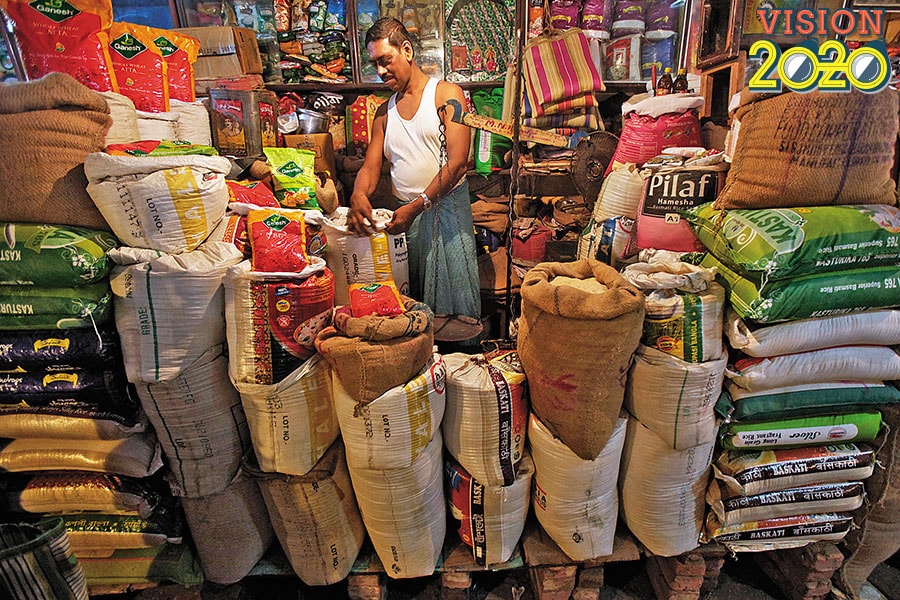
How kiranas have weathered the age of ecommerce
Using convenience, ease of access and digitisation, they have fought the onslaught of supermarkets and ecommerce
 Despite the expansion of organised, modern retail and the arrival of ecommerce, kirana stores have remained the lifeblood of Indian consumers
Despite the expansion of organised, modern retail and the arrival of ecommerce, kirana stores have remained the lifeblood of Indian consumers
Image: Rupak De Chowdhuri / Reuters
The small mom-and-pop stores, referred to as kiranas, have significantly evolved over the last decade. Local kirana stores typically used to be closed format boxes wherein the owners used to sit with a plethora of stocks haphazardly dumped at the store entrance as well as behind the shop. With no room to move around, the stores had dingy interiors, dim lights, and old cabinets with a mix of assortment. Many of these kirana owners would leave their shops in the middle of the day to visit the local mandis (markets) and wholesale markets to refill their requirements, a trip that involved a long commute.

Today a small kirana store owner, whether in the outskirts of Shahdara in Delhi or Malleswaram in Bengaluru, orders his stock online from an organised wholesaler and the same is delivered at his store within 24 hours. He stocks only what he requires while using the wholesaler as a warehouse, freeing himself from the daily trips to the local wholesale market. This is the modern-day scenario of grocery retailing wherein kirana owners are seeking convenience and ease of access.
In India, close to 12 million small mom-and-pop stores dominate domestic grocery retailing with a whopping 90 percent share. After agriculture, it is the second-largest source of employment generation and livelihood for millions of local entrepreneurs. On average, each of these kiranas serves a catchment comprising 500 to 1,000 families and over the last decade the humble kirana has been fighting the onslaught of supermarkets, modern retail and ecommerce players.
People in India still depend on their friendly neighbourhood kiranas for their daily essential needs. These shops usually ensure same-day delivery or free delivery, usually within an hour, along with a handy credit facility for regular customers. One can never beat a kirana owner’s understanding of the consumption pattern of the local community, their accessibility and the variety of locally relevant goods they stock. Additionally, the biggest arsenal for kiranas is their business model; it is easier to set up a kirana shop with a smaller stock-keeping unit vis-à-vis a retail store with enormous capital cost and inventory.
India’s retail market is pegged at close to $700 billion and is estimated to grow to $1 trillion in the next four to five years. Around 90 percent of this market is unorganised, made up mostly of the neighbourhood mom-and-pop stores. The origin of retailing in India can be traced back to the emergence of these stores that have been built on a strong foundation of trust for generations and easy accessibility to customers. The humble kiranas have become the backbone of the Indian grocery market and have proved extremely durable over the years. Despite the storied expansion of organised, modern retail and the arrival of ecommerce, kirana stores have remained the lifeblood of Indian consumers.
'AI in retail is the next step': Big Basket's Hari Menon
Of late there has been an increasing dissent about the way the new-age players are using predatory pricing, deep discounts, and inventory controlling, and giving preferential treatment to select sellers, which is consequentially hurting the business of these small mom-and-pop stores. Many of these new-age giants come with deep pockets and can afford to remain in losses for a longer period. But kirana owners’ livelihood is completely dependent on their stores and they cannot afford to make losses even for a month. Today, there is a lot of debate on the merits and demerits of ecommerce in India. The cost of customer acquisition for online retailers is soaring, leading to a huge cash burn rate and mounting losses. The need of the hour is to safeguard the interest of small kiranas and micro, small and medium enterprises against any regulatory violation and predatory pricing that is affecting their business and livelihood.
Kiranas today need help with the transformation. There are several technological solutions to empower kiranas and bring them into the mainstream. The more sustainable solutions being digitisation, modernisation and remodelling of stores, PoS (point-of-sale) billing, app-based digital payment, back-end integration of kiranas, and competitive pricing with discounts for them to stay relevant in the retail landscape. With kiranas accounting for 90 percent of retail sales in our country this change has been the most significant in the last decade. The PoS system enables kiranas to track sales, revenue, inventory and customer preference like any modern retailer.
'Tech-led startups have over $100 bln in market cap'
To help these stores thrive and complement online businesses, Metro has championed the cause of digitising kiranas. We rolled out our ‘Kirana Success Center’ in select cities to empower the kirana community with a one-stop modernisation and digitisation solution. Under this programme, we have digitised operations of over 2,000 kiranas, helping them attract more footfalls and profitability. Additionally, we have partnered with a startup ePayLater to co-create a mobile application—‘Digital Shop’—to transform these neighbourhood stores into a digital shop instantly using their existing smartphones. Through this mobile app, we have digitised over 10,000 small traders and kiranas across the country. Our kirana intervention programmes are aligned with the government of India’s impetus to digitise small retailers and shopkeepers. We intend to facilitate a more level-playing field for these small and independent businesses and help them stay relevant in the competitive retail landscape.
Kirana stores are an integral part of the Indian retail world; they operate on lower operational costs, making them more sustainable, unlike the retail and online businesses which are sitting on a pile of debt and face an unsustainable future. In the last decade, kiranas have proved to be nimble and adaptable. As a result, they are here to stay. Their intimate knowledge of the local consumer community coupled with smart inventory handling help them to better utilise the limited store space and turn over goods smartly. Despite the competitive landscape, these stores have proved to be extremely durable. The future is not a question of offline versus online, but how online can complement offline as both will continue to thrive in different ways.
To read all the Forbes India Vision 2020 essays, Click Here
(This story appears in the 17 January, 2020 issue of Forbes India. To visit our Archives, click here.)














